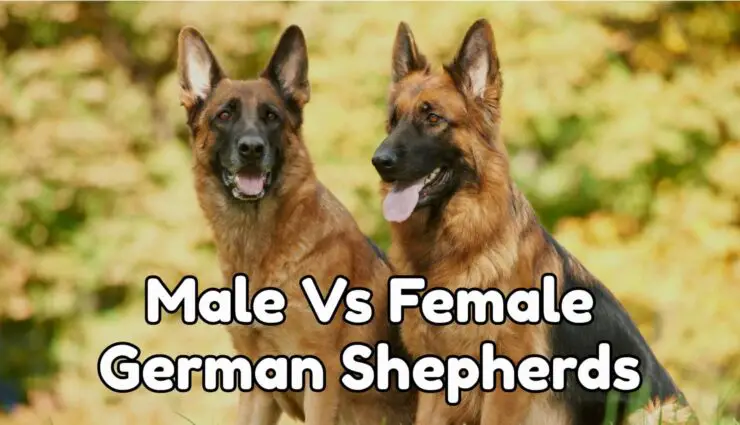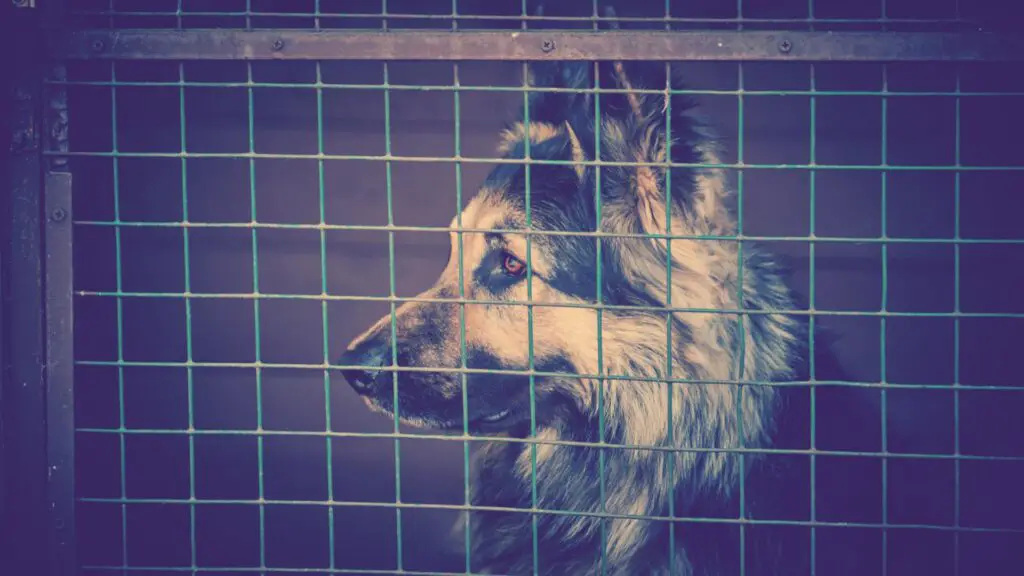German Shepherds always make it to the list of the top five breed choices for someone deciding to get a canine friend. Nevertheless, if they indeed decide to go for a German Shepherd, the next big question is the choice between a male vs female German Shepherd dog.
It is pertinent to mention here that both the genders of GSD are ideal as first dogs. This is because of their fascinating history that evolved along with the human race itself. The GSD breed, in particular, has been a friend of humans since the hunter-gatherer days of the human race. Amazing, right?
Remarkable fact: GSD breed wins the Award for Canine Excellence (ACE) more commonly than any other breed.
Coming back to the primary question about choosing a male vs female German Shepherd, some meaningful things can assist you in deciding.
What is the primary physical difference between a male vs female German shepherd?
This breed belongs to the classification of animals that display diverse physical characteristics between the two genders of the same breed. Both genders might look strikingly same at first sight. Yet, the female GSD is leaner and lighter in build than the male counterpart. This substantial difference between the male and female German shepherds is dominantly because of the hormones.
Interesting fact: Female German shepherds look more graceful than the male GSDs.
There are 3 primary physical differences between the male vs female German shepherds that help to differentiate between both the genders:
- Weight – Once more, female German shepherds are leaner than males. Hence, the weight of both the genders varies. Typically, a fully grown male GSD would weigh around 88 pounds to 66 pounds. However, the female German shepherd would weigh 48 pounds to 70 pounds. The whopping weight difference is around 66 pounds when considered on the higher end.
- Size – Due to hormonal factors, the female German shepherd is a bit smaller than the males. An adult male German shepherd would be 24 inches to 26 inches tall, while a female would be 22 inches to 24 inches tall. The difference in height between both the genders is about 2 inches.
- Coat – Both the genders carry a fluffy mane. Additionally, both are heavy shedders and have a double-coat of fur. Consequently, there is no primary difference between the qualities of their coats. But since the female German shepherd is leaner, hence her coat might appear to be a little thinner than the male GSDs.
Helpful fact: Female GSDs are not as bulky as males.
What about the temperament and personality of both genders of the German shepherd?
Both genders of GSDs are very energetic and always ready to play. This is the general temperament and personality of the GSD dog breed. However, the female German shepherds are a bit delicate than the males. Other than this, the male GSD is also more territorial than the females.
Consequently, it becomes more vital to tame their temperament since they mightn’t follow your rules if they find you aren’t a confident and patient leader.
On the other hand, a female GSD is not territorial but very protective of their families. However, you can train both the genders effectively by teaching them your rules despite following them. Your vigilance remains the key factor that would determine if you can discipline their territorial behavior or not.
Your unmistakable influence can govern them about how to behave, what places are off-limits, etc.
Fast fact: Female GSDs are more protective towards the owner’s family, especially the children.
The below mentioned differences in the temperament and personality of the two sexes of GSDs can help you to determine which gender could be better than your first dog.
- The male German shepherd is aggressive, which is why they develop a tendency to be confrontational when they feel threatened. Nevertheless, they are wary of everyone familiar to them. On the other hand, female GSDs are quite reserved and protective towards their young ones, including her owner’s.
- Both the genders of GSDs are playful and energetic. But males require more space to run around, primarily due to their size. Hence, families with small houses often prefer the female counterpart as their first dog. Nevertheless, exercise needs and energy levels of both the genders are the same and, they would require some space to run and release their energy.
- Since male counterpart is bigger than the females hence, they require more food. You might notice that a male eats three times a day, while the female counterpart eats only once or twice in a day. Needless to say, food habits definitely depend on the weight, age, health, physical activity, quality of food, etc. and these affect the food requirement of any German shepherd dog.
- Male counterpart being more aggressive than the females, his behavior could be uncertain towards strangers. On the other hand, female counterparts of the German shepherd dog breed are much more welcoming. This is also due to their sensitive nature, which makes them gentler and helpful. However, introducing your close friends and family to any of the genders must be done, preferably when they are young puppies. It will, on top, make them more social.
Helpful fact: Female GSDs are more sociable than the male counterparts of the breed. But, both the counterparts are equally protective towards the family.
Also read: Working line vs show line German shepherd
Which gender needs training and how to do it?
If we look at a male vs female German shepherd, then both the genders need training equally. However, the female counterpart of the GSD breed is comparatively easier to train. But, training the male counterpart is more important and beneficial for the dog owners. It is because of the male’s aggressive nature and protective outlook. Training will help to discipline the male German shepherd while the females can learn about their agility.
Here are some tips to know before you train your first dog:
- Always remember your dog is from the breed of hard-working dogs. GSDs were used explicitly for herding and guarding. Hence, they are excellent sniffer dogs. Plus, they are eminently capable in search and rescue. Training such a wonderful dog would be like killing two birds with a stone. You will get an obedient pooch at your side and he/she will get the needed stimulation.
- The most valuable thing you can do for your furry friend is establishing yourself as a capable leader. However, you must not mistake this as exhibiting yourself as “Alpha” because your pooch knows you are a human and would never accept you as the “alpha.” Alternatively, demonstrate to him/her that he/she can feel secure around you and look up to you for guidance.
- Your body language and tone of voice are the two most important things through which your dog would understand your command and mood. On top, they can understand your single direct commands such as “sit”, “come”, “drop”. Calm, simple commands with confident body language will convey the message clearly.
- The world of dogs is not colorful. They don’t understand what compromise means. It is essential to remember this when training your dog with vocal commands. Your first dog would look towards you as a consistent commander. Putting it simply, you have to stick to this command without adding anything. For example, some owners use “come” and sometimes change this command to “come here.” And when the dog doesn’t understand this changed command, then they feel frustrated.
- Your dog should be completely attentive towards you, before commencing the training. For example, when you train your GSD at a park then you do not have any control over the distractions and this is why you also do not get the full attention of your dog. Therefore, select a quiet place with little or no distractions. And when you are confident about your training, then only you can step-up to places with more distractions.
- Never forget the world’s golden rule- positive reinforcement produces constructive results. In simple words, reward your GSD’s good behavior with treats and praise both. It will inspire him/her and instill confidence as well.
Valuable hacks when training your first dog:
- Aggressive methods are not effective when training a GSD.
- Establish an understanding first between your dog and you.
- Leadership is all about using brains, being patient and being compassionate.
- Positive reinforcement is vitally necessary for your dog’s training.
So, what would be the pros and cons of the German shepherd breed whether male or female?
There are inevitably some inherent personality traits in every dog breed. Hence, it becomes important to mention the pros and cons that a German shepherd as your first dog would possess. The males are highly protective but aggressive and stubborn as well, whereas the females are gentler and more obedient but not so good as guard dogs.
Both the genders have their goods and bads. Knowing that would also help you to decide between a male vs female German shepherd, which one will fit in your life and your house better.
Positives of male GSDs –
- Since males are highly protective and territorial about their living place, they are the perfect guard dogs. They will never allow any intruder or an unknown person to break-in the wake of the night. Also, their wolf-like appearance helps to instill fear in the minds of the intruders. Moreover, if you live in a place where there is a chance to encounter any wild animal, then the GSDs will protect your home instead of running away.
- Male GSDs look forward to their owners for companionship. They wouldn’t ever let you feel alone and, would lighten up your mood with their affection. Hence, this breed is not only good as a guard dog but also as a companion.
Negatives of male German shepherds –
- Representing an aggressive breed, especially the male GSDs are prone to be stubborn about receiving instructions from other members of the family.
- The lifespan of the male counterpart is comparatively lesser than the females. However, both genders may develop some health issues which can be avoided with regular exercise and proper diet.
- Male GSDs require a capable handler because they themselves are pretty strong and quite sizable.
Now, let’s take a look at the pros and cons of the female counterpart of the GSD breed.
Positives of female GSDs –
- The female counterpart of the dog breed is highly preferable as a more sensitive and gentle pet. The males can be taught to be relaxed but, it comes naturally to the females. Plus, female GSDs possess the inherent instinct of nurturing and protection which makes them a better choice for families with small children.
- Females GSDs are smaller. This makes them ideal for spending time indoors, especially for families living in a small house. The slender body of females won’t be in the way as much as the large male GSDs. Nonetheless, a German shepherd breed of the dog falls in the range of medium-sized to large-sized species consequently, both the genders would require a bit of space.
Negatives of the female German shepherd –
- Females GSDs are most likely to run away in the event of a disaster. On top of that, they are less confrontational and territorial which makes it harder to train them as guard dogs. Even after rigorous training, you might not win her over to face challenging moments.
- If you do not opt to spay, then this could be one of the negative things you might face. The female gender of the GSD breed goes into heat a couple of times every year. This causes heavy bleeding throughout the day till she is into heat. During this natural cycle, you would require to keep your dog clean till she recovers.
What are the most probable health issues that both the genders of GSD are likely to face?
The most common health issues faced by both the sexes are perianal fistula, megaoesophagus, hip dysplasia, osteoarthritis and degenerative myelopathy. Let read about them in details.
- Perianal Fistula – This disorder affects all dog breeds. But the German shepherd is specifically prone to suffer from it. You will notice this when the skin around the anus drains body liquids. Common signs of this disease are –
- Straining during defecation.
- Diarrhea or bloody stool.
- The dog would lick around the anal area frequently, to curb the pain.
- Megaesophagus – Megaesophagus is a disorder of the food pipe. When a dog is suffering from this health problem, his /her oesophagus (food pipe) becomes limp and fails to transport the eaten food efficiently to the stomach. The typical symptoms would include –
- Regurgitation towards when consuming solid food.
- Frequent vomiting.
- May appear malnourished.
- Defecate too less.
Fact: This disease cannot be cured.
- Hip Dysplasia – It is a general health issue and, it affects around 15% to 20% of the GSD population in the world. This problem is caused when the hip joint becomes loose. This problem may cause the dislocation of the hip bones. This disease is most frequently caused by obesity, injury, and/or strenuous physical activity for a long period of time. The possible signs would include –
- Unenthusiastic towards the daily physical activities.
- May looks discouraged about everything.
Tip: This disease is less likely to affect GSDs as compared to the other dog breeds.
- Osteoarthritis – If you wonder that hip dysplasia would be the prime reason for arthritis or hip dysplasia is the same as osteoarthritis as you are mistaken. Because hip dysplasia is a completely different disorder affecting the hip joints due to reasons mentioned in that section, whereas osteoarthritis is commonly caused by normal wear and tear of the bones. And, it is a widespread disorder amongst all the large and medium-sized dog breeds. The symptoms might include –
- Inflammation of joints.
- Demoralized to exercise or play.
- Degenerative myelopathy – It is a neurological disease. This affects the spinal cord of your dog. Imaging is required to diagnose this disease. You should consult with the vet when observing signs of –
- Rear limb weakness.
- Or, partial paralysis-like symptoms.
Helpful Tip: These disorders are unaffected from the comparison of male vs female German shepherd dog breed. Both genders could develop these disorders.
So, which gender should you go for- male vs female German shepherds?
It completely depends on your lifestyle, your family, and your requirements. But most importantly, it depends on your lifestyle.
Males are wonderful as a friend to exercise with, and females are wonderful as a well-behaved member of the family, especially with small children.
So, if you have children in your family, you should definitely go for a female. But, if you’re solely looking for a companion, then the male is a better choice.
Nevertheless, adding a pet to your life is definitely going to increase your responsibilities. So, whatever gender of GSD you may choose, never underestimate the importance of training.
Also, try to get your first dog when he/she is still a pup because coping up and befriending a grown-up dog is quite a hard task. Plus, they are not ideal for a family.
Last words
The comparison of a male vs female German shepherd is essential before bringing home your buddy. However, strong built, intelligence, alertness, and loyalty represent the general characteristics of a German shepherd dog breed. The usefulness of this dog breed can be understood clearly by the fact that their abilities are enthusiastically praised by the police and military as well as dog owners.





